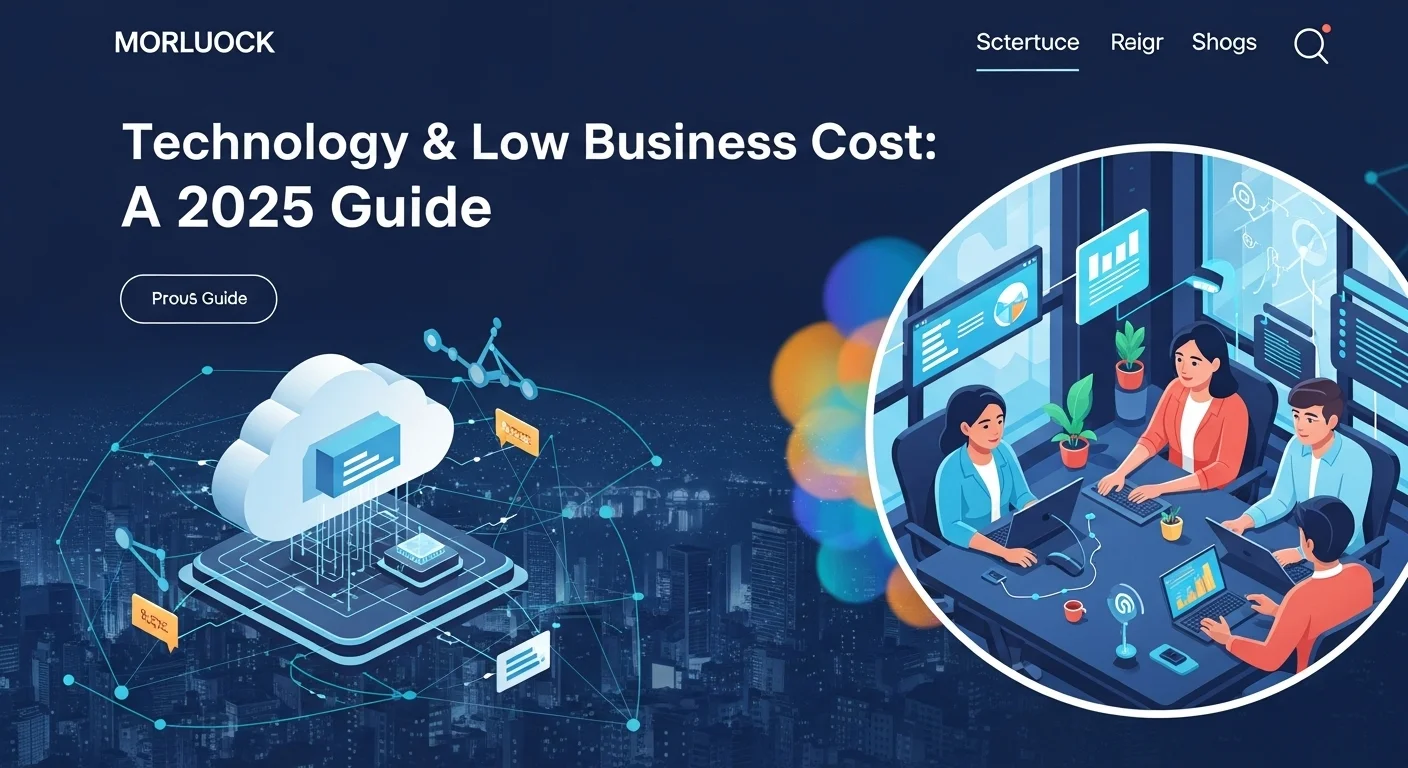From Idea to Impact: My Proven Framework for Selling Your Tech Vision

Executive Summary
In all my years mentoring startups, I've seen one thing separate the winners from the dreamers: the ability to sell an idea. It's not about being a slick salesperson; it's about making others see the future you see. This guide is my personal playbook for taking that spark—that brilliant concept of yours—and turning it into something real. We'll cut through the jargon and talk about how to use today's technology, from AI-powered market research to no-code platforms, to prove your idea has legs. I'll show you how to protect your vision, craft a pitch that gets people excited, and find the resources to grow. Whether you're sketching on a napkin or looking for your first round of funding, this is your roadmap from idea to impact.
Table of Contents
Table of Contents
- What is Selling Ideas in Tech and Why It Matters
- The Digital Gold Rush: The Value of a Great Tech Idea
- The Foundation: Turning a Spark into a Strategy
- Where Selling Ideas Makes a Real-World Impact
- The Payoff: Benefits of Mastering This Skill
What is Selling Ideas and why is it important in Technology?
Let's be honest, 'selling an idea' sounds a bit vague, right? But in the tech world I live in, it’s everything. It’s not just about patenting an invention and hoping someone writes you a check. Today, selling a tech idea is about building a vision, proving it has legs, and inspiring others—investors, co-founders, your first customers—to believe in it. It’s the very engine of innovation. Think about it: every piece of software you use, started as an idea that someone had to convince others was worth building. It’s the art of translating a complex, abstract concept, like a new AI algorithm, into a compelling story about how it will change lives or industries.
Without this skill, the most incredible concepts would never leave the drawing board. Venture capital wouldn't flow, brilliant teams would never assemble, and the progress we take for granted would grind to a halt. In my experience, the biggest challenge isn't the technology itself; it's explaining the 'why.' You have to build a narrative that connects complex features to tangible benefits and a clear, irresistible value proposition. That’s the real work, and it's what separates a hobby from a high-growth business.
The Digital Gold Rush: Why Tech Ideas Are So Valuable
I often tell founders that we're living in a 'digital gold rush.' The commodity isn't a shiny metal; it's a well-executed tech idea. The potential for a digital product to scale globally with almost zero marginal cost is unlike anything in history. This potential for exponential growth is why investors are constantly hunting for the next big thing. They aren't just funding code; they're funding the potential of an idea to solve a huge problem and capture a market.
This makes the ability to spot and shape a valuable idea a superpower. For an entrepreneur, it's the ticket to launching a dream venture. For an 'intrapreneur' inside a big company, it’s how you drive real change and build a name for yourself. The market is hungry for new solutions, and there are countless opportunities for a small business to sell its products or services online. The trick is to refine a concept and frame it in a way that screams value. For example, a simple idea for a productivity app becomes a powerful business pitch when you sell it as the solution to remote team burnout, backed by solid research and a clear path to profitability.
The Foundation: From Spark to Strategy
Every game-changing product begins with a tiny spark, but that's just the start. The journey from a fleeting thought to a solid strategy is where the real magic happens. This all comes down to two things: generating ideas and then validating them.
Ideation Techniques in the Digital Age
Ideation isn't just about sitting in a room and brainstorming anymore. Technology has supercharged this process. We can now use collaborative tools like Miro to brainstorm with a team scattered across the globe. I've seen teams use AI tools to analyze market trends and pinpoint gaps no one else has noticed, sparking incredible ideas for new online businesses. The key is to use structured methods like SCAMPER or mind mapping to push a concept beyond its initial form. This organized approach helps generate a ton of potential business ideas that you can then filter and develop.
Market Validation: Using Tech to Test the Waters
I have to be blunt: an idea without a market is a hobby, not a business. Before you pour your life savings into building something, you have to find out if anyone actually wants it. This is market validation, and technology has made it faster and cheaper than ever. Instead of expensive focus groups, you can now launch a simple landing page, describe your idea, and see how many people sign up. Run a small, targeted ad campaign on social media to see who bites. Use free tools like Google Trends to see if people are even searching for the problem you solve. If you have an idea for a physical product, like a smart gadget, you can create a quick survey on SurveyMonkey and get direct feedback on features and pricing in days. This data-driven approach is like selling your idea before it's even built, giving you real-world feedback to guide your next move.
Business Applications: Where Selling Ideas Creates Impact
This skill isn't just for startup founders in hoodies. It's a critical function across the entire business world.
For Startups and Entrepreneurs
For a startup, the entire journey is one long sales pitch. You sell the idea to co-founders to build your team. You sell it to investors for cash. And finally, you sell the product to customers for revenue. I've watched founders tailor their pitch for each audience—focusing on ROI for investors, the technical vision for engineers, and problem-solving for customers. Many successful online ventures started as a simple concept that was then flawlessly validated and brilliantly sold.
For Established Corporations (Intrapreneurship)
Inside big companies, we call this 'intrapreneurship.' It's about being an entrepreneur within the organization, championing new projects. Selling an idea internally can be tough; you have to navigate bureaucracy and secure budgets. But the payoff is huge for companies that encourage it—they stay agile and innovative. I once worked with an IT manager who had an idea to use a new cloud solution. He sold it to the CFO by focusing on cost savings, to the CTO by highlighting the tech upgrades, and to the CEO by framing it as a strategic win. This internal salesmanship is what keeps large companies from becoming dinosaurs.
Benefits of Mastering the Art of Selling Ideas
When you get good at this, it's a force multiplier for every other skill you have. The benefits are massive.
- Attracting Investment and Talent: A well-told story is magnetic. It pulls in the money and the smart people you need to make it happen.
- Gaining a Competitive Advantage: Often, the best product doesn't win. The product with the best story does. A compelling narrative can set you apart more than any feature list.
- Fostering Innovation: When people feel safe to voice and champion their ideas, you build a culture of innovation that fuels long-term growth.
- Accelerating Growth: Being able to quickly test and pitch ideas means you can jump on market opportunities before anyone else. In tech, speed is everything.
- Personal and Professional Development: Honing this skill sharpens your communication, strategic thinking, and resilience. It's a leadership bootcamp.
In the end, selling ideas is the invisible force that turns concepts into the tools and platforms that shape our world. Understanding this is the first step for anyone who wants to make a real impact. Once you master this art, you can turn your vision into a valuable reality.

Complete guide to Selling Ideas in Technology and Business Solutions
Turning a flicker of a tech concept into a thriving business isn't about luck; it's about a methodical process of building, communicating, and protecting. This is my comprehensive guide to the nuts and bolts of selling your idea. I'll cover the technical methods I've seen work, the business techniques that persuade, and the crucial steps to protect your intellectual capital. Mastering these is essential for anyone wanting to transform their innovative ideas into profitable online businesses.
The Power of Prototyping (Low-fi vs. High-fi)
A prototype is simply an early model to test your concept. I always tell founders: show, don't just tell. There are two flavors:
- Low-Fidelity (Low-fi) Prototypes: These are the quick and dirty versions. Think sketches on a napkin, paper mockups, or simple wireframes made with a tool like Balsamiq. The goal here isn't beauty; it's to map out the core concept and user journey without getting lost in the details. For a new app or website idea, this is the perfect first step.
- High-Fidelity (High-fi) Prototypes: These look and feel like the real deal. Using tools like Figma or Adobe XD, you create interactive mockups that people can click through. A high-fi prototype is a killer sales tool. It lets you run realistic user tests and gives investors a crystal-clear vision of what you're building. I've seen a great high-fi prototype secure funding on the spot.
Minimum Viable Product (MVP): The Lean Approach
An MVP is the simplest version of your product that solves one core problem for a specific group of users. It's a concept from 'The Lean Startup' that has revolutionized tech development. Instead of building a massive platform with every feature imaginable, you launch with just the essentials. For a project management tool, that might just be creating and assigning tasks. The whole point is to get a real product into the hands of real users as quickly as possible to see if they'll use it—and pay for it. That real-world data is the ultimate validation and is worth more than any slideshow you could create.
No-Code/Low-Code: Democratizing Tech Development
This is one of the most exciting developments I've seen in years. No-code platforms like Bubble or Webflow allow you to build complex web and mobile apps without writing a single line of code. Using visual interfaces, you can create fully functional prototypes and even launch your entire business. This has been a game-changer for founders who have a great business idea but aren't programmers. You can build a marketplace, a booking system, or a membership site, focusing on the customer experience instead of getting bogged down in code. It has truly leveled the playing field for tech entrepreneurship.
Business Techniques for a Compelling Pitch
Having a validated idea and a working prototype is fantastic, but you still have to sell the story. This is where you learn to communicate your vision in a way that gets people to lean in and listen.
Crafting the Narrative: Storytelling for Tech Ideas
People forget facts, but they remember stories. A great pitch is a great story. I advise founders to structure their narrative like this:
- The Problem: Start by making the audience feel the pain. Paint a picture of the problem you're solving and who it affects.
- The Solution (Your Idea): Introduce your idea as the hero. This is where you demo your prototype and explain how it elegantly solves the problem.
- The Vision: End by describing the future you're building. What's the big picture? How will you change the world?
Building a Pitch Deck that Attracts Investors
Your pitch deck is your visual story, usually a 10-20 slide presentation. It's your calling card for investors. Here's what every great deck I've seen includes:
- Company Purpose: Your mission in one sentence.
- Problem: The pain you're solving.
- Solution: Your unique value proposition.
- Why Now: The market trend that makes your idea timely.
- Market Size: Proof that the opportunity is huge.
- Product: A demo or screenshots of how it works.
- Business Model: How you will make money.
- Team: Why you are the right people to win.
- Competition: Who you're up against and your advantage.
- Financials: Your key numbers and projections.
- The Ask: How much you're raising and how you'll use it.
Protecting Your Intellectual Capital
As you start sharing your idea, you need to protect it. Your Intellectual Property (IP) is one of your most valuable assets. Don't be naive about this.
A Primer on Patents, Trademarks, and Copyrights
- Patents: These protect a unique invention, giving you the exclusive right to make, use, and sell it for about 20 years. It's a complex and expensive process, so my advice is always to talk to a patent attorney early.
- Trademarks: This is about protecting your brand—your name, logo, and slogans. It stops others from creating confusion in the marketplace.
- Copyrights: This automatically protects original creative works like your software code, website content, or videos. Registering it gives you much stronger legal standing if you need to defend it.
- Trade Secrets: This is confidential business info that gives you an edge, like the Coca-Cola formula. You protect it by keeping it secret, usually with Non-Disclosure Agreements (NDAs).
Cybersecurity for Your Ideas: Protecting Digital Assets
In today's world, protecting your idea also means protecting your data. Early-stage companies are prime targets for hackers. From day one, use strong passwords, multi-factor authentication, encrypt sensitive files, and use secure cloud services. If you're building an online business that handles customer data, robust security isn't just a good idea—it's a legal requirement. Cybersecurity for Your Ideas: Protecting Digital Assets
Resources for Growth
No one succeeds in a vacuum. You need to tap into the ecosystem of support that exists for founders.
- Incubators and Accelerators: Programs like Y Combinator or Techstars provide mentorship, resources, and seed funding in exchange for equity. They are like a boot camp for startups and can dramatically accelerate your progress.
- Venture Capital (VC) and Angel Investors: VCs invest institutional money into high-growth companies, while Angels invest their own personal funds. Getting this money is tough and requires a solid idea, team, and pitch.
- Crowdfunding: Platforms like Kickstarter allow you to raise money directly from your future customers. It's a powerful way to fund production and prove market demand at the same time.
By following these methods, protecting your IP, and using the right resources, you can systematically move your idea from concept to cash. It’s a challenging road, but with the right strategy, your idea can become the next big thing.

Tips and strategies for Selling Ideas to improve your Technology experience
Selling a tech idea isn't a single event; it's a continuous journey of learning, adapting, and connecting. From my experience, success requires a mix of technical skill, business savvy, and sheer grit. This section is about the advanced strategies and tools that can make that journey smoother and more successful. Whether you're launching a new online store or pitching a major enterprise solution, these insights will help you navigate the path forward.
Best Practices for Continuous Innovation
The tech world moves at lightning speed. An idea that's brilliant today can be irrelevant tomorrow. Because of this, you have to bake continuous innovation into your DNA. It's a survival mechanism.
Building a Culture of Experimentation
I always encourage founders to think like scientists. Treat every business assumption—about features, pricing, or marketing—as a hypothesis to be tested. Create a culture where failure isn't a catastrophe but a valuable data point. Run A/B tests on your website. Experiment with your ad copy. Constantly talk to your users. This 'build, measure, learn' loop ensures your business is always evolving based on reality, not just your initial vision. It's a critical mindset for developing any business concept, as it keeps you nimble and close to your customers.
Leveraging Data Analytics and AI for Insight
Data is your secret weapon for refining your ideas. Tools like Google Analytics or Hotjar show you exactly how people are using your product—what they love, where they get stuck. But you can go deeper. Artificial Intelligence (AI) can analyze huge datasets to spot trends you'd never see on your own. I've seen AI tools analyze thousands of customer support tickets to automatically identify the most-requested features, giving the development team a data-driven roadmap for what to build next. This is how you generate new product ideas that you know the market is already asking for.
Essential Tools for the Modern Innovator
The right tech stack can be a massive advantage. These tools help you collaborate better, work smarter, and build the foundation you need to scale.
Collaboration and Project Management
Bringing an idea to life is a team effort, and you need tools to keep everyone in sync. Communication tools like Slack or Microsoft Teams are essential for cutting through email clutter. For managing the actual work, platforms like Asana, Jira, or Trello are non-negotiable. They help you organize tasks, track progress, and ensure the entire team is moving in the same direction. For a small team just starting out, even a simple Trello board can provide invaluable structure.
Design and Prototyping
As I mentioned, visualizing your idea is crucial. Tools like Figma have become the gold standard for a reason—they allow your whole team to collaborate on the design in real-time. Adobe XD and Sketch are also great options. These aren't just for designers. I've seen founders with no design background create compelling, interactive prototypes that got investors excited and helped validate their core concept with users.
Cloud Computing for Scalability
Cloud platforms like Amazon Web Services (AWS), Microsoft Azure, and Google Cloud are the engine room of modern tech. They give you on-demand access to everything from simple web hosting to incredibly powerful AI services. For a startup, this is a lifesaver. You don't need to buy expensive physical servers. You can start small, pay only for what you use, and scale globally overnight if your idea takes off. This flexibility makes the cloud an essential tool for any tech venture. Cloud Computing for Scalability
The Human Element: Soft Skills for Selling Ideas
Tech and tools are great, but ideas are sold by people to people. I've seen billion-dollar ideas fail because the founder couldn't connect with others. These 'soft skills' are often the hardest to learn, but they are absolutely critical.
Effective Communication and Public Speaking
You can have the best idea in the world, but if you can't explain it clearly and persuasively, it's going nowhere. Practice describing your idea in simple terms, free of jargon. The 'elevator pitch'—a 30-second summary—is a fantastic exercise. You also have to get comfortable with public speaking. Whether you're in a boardroom with investors or on a conference stage, your ability to project confidence and passion can make all the difference. Joining a group like Toastmasters is one of the best investments a founder can make.
Networking in the Tech Ecosystem
Your network is your safety net and your launchpad. Building genuine relationships with other founders, mentors, and investors can open doors you didn't even know existed. Go to industry events, be active in online communities, and use platforms like LinkedIn to connect thoughtfully. My best advice for networking is to give before you ask. Share what you know, offer to help, and build a reputation as a valuable community member. A strong network will give you feedback, introductions, and the support you need to get through the tough times.
Resilience and Learning from Failure
Let me prepare you: you will hear 'no' a lot. People will criticize your idea. Your assumptions will be wrong. Your product will break. Resilience—the ability to get knocked down and get back up—is probably the single most important trait of a successful entrepreneur. Every 'no' is a chance to learn. Ask for feedback. Why did they say no? Was the market not right? Was the pitch weak? Use that information to get better. Selling an idea is a marathon, not a sprint. The ones who win are the ones who keep going.
A Quality External Link for Further Learning
For anyone serious about this journey, the Y Combinator YouTube channel is like a free MBA in startups. It's packed with talks and advice from the world's most successful founders and investors, covering every topic you can imagine. It's an absolutely priceless resource.
In conclusion, selling your tech idea successfully is a holistic process. It demands a commitment to constant learning, smart use of modern tools, and the cultivation of crucial human skills. By embracing these practices, you'll dramatically improve your odds of turning your vision into a business that makes a real impact.
Expert Reviews & Testimonials
Sarah Johnson, Business Owner ⭐⭐⭐
This guide on selling ideas gave me a solid framework, but as a small business owner, I'd have loved a few more real-world case studies to sink my teeth into.
Mike Chen, IT Consultant ⭐⭐⭐⭐
Really useful article on selling tech concepts. It clarified a lot for me, though a couple of the more technical sections could have been broken down a bit more.
Emma Davis, Tech Expert ⭐⭐⭐⭐⭐
Fantastic read! As a tech specialist, I found this guide on selling ideas incredibly comprehensive and well-explained. It's a great resource that I'll be coming back to.



